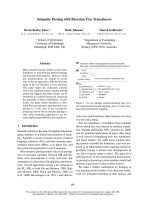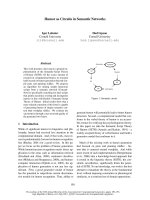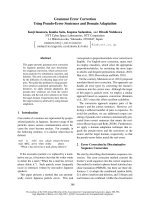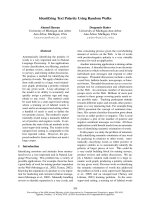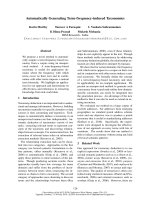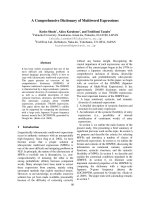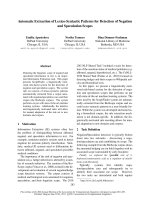Tài liệu Báo cáo khoa học: "Automatic Headline Generation using Character Cross-Correlation" doc
Bạn đang xem bản rút gọn của tài liệu. Xem và tải ngay bản đầy đủ của tài liệu tại đây (188.2 KB, 5 trang )
Proceedings of the ACL-HLT 2011 Student Session, pages 117–121,
Portland, OR, USA 19-24 June 2011.
c
2011 Association for Computational Linguistics
Automatic Headline Generation using Character Cross-Correlation
Fahad A. Alotaiby
Department of Electrical Engineering,
College of Engineering, King Saud University
P
.
O
.
Box
800
,
Riyadh
11421
,
Saudi Arabia
Abstract
Arabic language is a morphologically com-
plex language. Affixes and clitics are regu-
larly attached to stems which make direct
comparison between words not practical. In
this paper we propose a new automatic
headline generation technique that utilizes
character cross-correlation to extract best
headlines and to overcome the Arabic lan-
guage complex morphology. The system
that uses character cross-correlation
achieves ROUGE-L score of 0.19384 while
the exact word matching scores only
0.17252 for the same set of documents.
1 Introduction
A headline is considered as a condensed summary
of a document. It can be classified as the acme of
text summarization. The necessity for automatic
headline generation has been raised due to the need
to handle huge amount of documents, which is a
tedious and time-consuming process. Instead of
reading every document, the headline can be used
to decide which of them contains important infor-
mation.
There are two major disciplines towards auto-
matic headline generation: extractive and abstrac-
tive. In the work of (Douzidia and Lapalme, 2004),
and extractive method was used to produce a 10-
words summary (which can be considered as a
headline) of an Arabic document, and then it was
automatically translated into English. Therefore,
the reported score reflects the accuracy of the gen-
eration and translation which makes it difficult to
evaluate the process of headline generation of this
system. Hedge Trimmer (Dorr
et al.
, 2003) is a
system that creates a headline for an English news-
paper story using linguistically-motivated heuris-
tics to choose a potential headline. Jin and
Hauptmann (2002) proposed a probabilistic model
for headline generation in which they divide head-
line generation process into two steps; namely the
step of distilling the information source from the
observation of a document and the step of generat-
ing a title from the estimated information source,
but it was for English documents.
1.1 Headline Length
One of the tasks of the Document Understanding
Conference of 2004 (DUC 2004) was generating a
very short summary which can be considered as a
headline. The evaluation was done on the first 75
bytes of the summary. Knowing that the average
word size in Arabic is 5 characters (Alotaiby
et al.
2009) in addition to space characters, the specified
summary size in Arabic words was roughly
equivalent to 12 words. In the meantime, the aver-
age length of the headlines was about 8 words in
the Arabic Gigaword corpus (Graff, 2007) of ar-
ticles and their headlines. In this work, a 10-words
headline is considered as an appropriate length.
1.2 Arabic Language
Classical Arabic writing system was originally
consonantal and written from right to left. Every
letter in the 28 Arabic alphabets represents a single
consonant. To overcome the problem of different
pronunciations of consonants in Arabic text, graph-
117
ical signs known as diacritics were invented in the
seventh century. Currently in the Modern Standard
Arabic (MSA), diacritics are omitted from written
text almost all the time. As a result, this omission
increases the number homographs (words with the
same writing form). However, Arab readers nor-
mally differentiate between homographs by the
context of the script.
Moreover, Arabic is a morphologically complex
language. An Arabic word may be constructed out
of a stem plus affixes and clitics. Furthermore,
some parts of the stem may be deleted or modified
when appending a clitic to it according to specific
orthographical rules. As a final point, different or-
thographic conventions exist across the Arab world
(Buckwalter, 2004). As a result of omitting diacrit-
ics, complex morphology and different orthograph-
ical rules, two same words may be regarded as
different if compared literally.
2 Evaluation Tools
Correctly evaluating the automatically generated
headlines is an important phase. Automatic me-
thods for evaluating machine generated headlines
are preferred against human evaluations because
they are faster, cost effective and can be performed
repeatedly. However, they are not trivial because
of various factors such as readability of headlines
and adequacy of headlines (whether headlines in-
dicate the main content of news story). Hence, it is
hard for a computer program to judge. Neverthe-
less, there are some automatic metrics available for
headline evaluation. F1, BLEU (Papineni
et al.
2002) and ROUGE (Lin, 2004
a
) are the main me-
trics used.
The evaluation of this experiment was performed
using Recall-Oriented Understudy for Gisting
Evaluation (ROUGE). ROUGE is a system for
measuring the quality of a summary by comparing
it to a correct summary created by human. ROUGE
provides four different measures, namely ROUGE-
n
(usually
n
= 1,2,3,4), ROUGE-L, ROUGE-W,
ROUGE-S and ROUGE-SU. Lin (2004
b
) showed
that ROUGE-1, ROUGE-L, ROUGE-SU, and
ROUGE-W were very good measures in the cate-
gory of short summaries.
3 Preparing Data
The dataset used in this work was extracted from
Arabic Gigaword (Graff, 2007). The Arabic Giga-
word is a collection of text data extracted from
newswire archives of Arabic news sources and
their titles that have been gathered over several
years by the Linguistic Data Consortium (LDC) at
the University of Pennsylvania. Text data in the
Arabic Gigaword were collected from four news-
papers and two press agencies. The Arabic Giga-
word corpus contains almost two million
documents with nearly 600 million words. For this
work, 260 documents were selected from the cor-
pus based on the following steps:
• 3170 documents were selected automati-
cally according to the following:
i. The length of the document body is be-
tween 300 to 1000 words
ii. The length of the headline (hereafter
called original headline) was between 7
to 15 words.
iii. All words in the original headline must
be found in the document body.
• 260 documents were randomly selected
from the 3170 documents.
After automatically generating the headlines, 3
native Arabic speaker examiners were hired to eva-
luate one of the generated headlines as well as the
original headline. Also, they were asked to gener-
ate 1 headline each for every document. These new
3 headlines will be used as reference headlines in
ROUGE to evaluate all automatically generated
headlines and the original headline.
4 Headline Extraction Techniques
The main idea of the used method is to extract the
most appropriate set of consecutive words (phrase)
from a document body that should represent an
adequate headline for the document. Then, eva-
luate those headlines by calculating ROUGE score
against a set of 3 reference headlines.
To do so, first, a list of nominated headlines was
created from the document body. After this, four
different evaluation methods were applied to
choose the best headline that reflects the idea of
the document among the nominated list. The task
of these methods is to catch the most suitable head-
line that matches the document. The idea here is to
118
choose the headline that contains the largest num-
ber of the most frequent words in the document
taking into account ignoring stop words and giving
earlier sentences in documents more weight.
4.1 Nominating a List of Headlines
A window of a length of 10-words was passed over
the paragraphs word by word to generate chunks of
consecutive words that could be used as headlines.
Moving the widow one word step may corrupt the
fluency of the sentences. A simple approach to re-
duce this issue is to minimize the size of para-
graphs. Therefore, the document body was divided
into smaller paragraphs at new-line, comma, colon
and period characters. This step increased the
number of nominated headlines with proper start
and end. The resulting is a nominated list of head-
lines of a length of 10 words. In the case of a para-
graph of a length less than 10, there will be only
one nominated headline of the same length of that
paragraph.
Table 1 shows an example of nominating headline
list where
a
is the selected paragraph,
b
is the first
nominated headline and
c
is the second nominated
headline. Nominated headlines
b
and
c
are word-
by-word translated.
a
ﻢﻟﺎﻌﻣ زوﺮﺒﺑ نادﻮﺴﻟا ﻲﻓ ﺔﯿﺑﺮﻌﻟا تﺎﻃﻮﻄﺨﻤﻟا ةﺄﺸﻧ ﺖﻄﺒﺗرا
ﺔﯿﺑﺮﻌﻟا ﺔﻓﺎﻘﺜﻟاﺔﯿﻣﻼﺳﻹا ،
The
emerging of the Arabic manuscripts in
Sudan was associated with the rise of the
formation of Arabic-Islamic culture,
b
ةﺄﺸﻧ ﺖﻄﺒﺗرا
ﻢﻟﺎﻌﻣ زوﺮﺒﺑ نادﻮﺴﻟا ﻲﻓ ﺔﯿﺑﺮﻌﻟا تﺎﻃﻮﻄﺨﻤﻟا
ﺔﯿﺑﺮﻌﻟا ﺔﻓﺎﻘﺜﻟا
Associated emerging manuscripts
Arabic
in
Sudan with-rise formation culture Arabic
c
ﺔﻓﺎﻘﺜﻟا ﻢﻟﺎﻌﻣ زوﺮﺒﺑ نادﻮﺴﻟا ﻲﻓ ﺔﯿﺑﺮﻌﻟا تﺎﻃﻮﻄﺨﻤﻟا ةﺄﺸﻧ
ﺔﯿﺑﺮﻌﻟاﺔﯿﻣﻼﺳﻹا
E
merging manuscripts
Arabic
in Sudan
with-rise formation culture Arabic Islamic
Table 1: An example of headlines nomination.
4.2 Calculating Word Matching Score
The very basic process of making a matching score
between every two words in the document body is
to give a score of 1 if the two words exactly match
or 0 if there is even one mismatch character. This
basic step is called the Exact Word Matching
(EWM). Unfortunately, Arabic language contains
clitics and is morphologically rich. This means the
same word could appear with a single clitic at-
tached to it and yet to be considered as a different
word in the EWM method. Therefore, the idea of
using Character Cross-Correlation (CCC) method
emerged. In which a variable score in the range of
0 to 1 is calculated depending on how much cha-
racters match with each other. For example, if the
word “ﺎﮭﺒﺘﻛو” “
and he wrote it
” is compared with
the word “ﺐﺘﻛ” “
he wrote
” using the EWM method
the resulting score will be 0, but when using the
CCC method it will be 0.667. The CCC method
comes from signals cross-correlation which meas-
ures of similarity of two waveforms. In the CCC
method the score is calculated according to the
following equation:
!"
#
$
,%
&
=
'()*
+
,
[
-
]
./0
(1)
and
1
[
2
]
=
3
4
5
[
6
]
78
9
[
:+;
]
<=>
?@A
(
BCD
)
(2)
where
w
i
is the first word containing
M
characters,
w
j
is the second word containing
N
characters and
the operation * result
1
if the two corresponding
characters match each other and
0
otherwise.
4.3 Calculating Best Headline Score
After preparing the two tables of words matching
score, now they will be utilized in the selection of
the best headline. Except stop-words, every word
in the document body (
w
d
) will be matched with
every word in the nominated headline (
w
h
) using
the CCC and the EWM methods and a score will
be registered for every nominated sentence. A sim-
ple stop-word list consisting of about 180 words
was created for this purpose. Calculating matching
score for every sentence is also performed in two
ways. The first way is the SUM method which is
defined in the following equation:
EFG
H
=
3 3
IJK
L
M
,N
O
P
QRS
T
UVW
(3)
where
SUM
p
is the score using SUM method for
the nominated headline
p
,
K
is the size of unique
words in the document body and
L
is the size of
words in the nominated headline (except stop-
words).
In this method the summation of the cross-
correlation score of every word in the document
body and every word in the headline is added up.
119
In a similar way, in the other method
MAX
p
the
maximum score between every word in the docu-
ment body and the nominated headline is added up.
Therefore, for every word in the document, its
maximum matching score will be added in either
cases, CCC or EWM. And it can be defined in the
following equation:
XYZ
[
=
3
max
\
]^_
`
a
,b
c
d
efg
(4)
SUM
p
and
MAX
p
were calculated using EWM
and CCC method resulting four different variation
of the algorithm namely SUM-EWM, SUM-CCC,
MAX-EWM and MAX-CCC.
4.4 Weighing Early Nominated Headlines
In the case of news articles usually the early sen-
tences absorb the subject of the article (Wasson,
1998). To reflect that, a nonlinear multiplicative
scaling factor was applied. With this scaling factor,
late sentences are penalized. The suggested scaling
factor is inspired from sigmoid functions and de-
scribed in the following equations.
hi = j
k
l
m
no
p
q
rs
j1
t
/2 (5)
where
u =5
v
wx
y
j 1
z
(6)
and
r
is the rank of the nominated headline and
S
is
the total number of sentences.
Figure 1: Scaling function of a 1000 nominated
headline document.
According the nominating mechanism hundreds
of sentences could be nominated as possible head-
lines. Figure 1 shows the scaling function of a one
thousand nominated headlines. After applying the
scaling factor, the headline with the maximum
score was chosen.
5 Results
Table 2 shows the ROUGE-1 and ROUGE-L
scores on the test data. ROUGE-1 measures the co-
occurrences of unigrams where ROUGE-L is based
on the longest common subsequence (LCS) of an
automatically generated headline and the reference
headlines.
It is clear that the MAX-CCC scores the highest
result in the automatically generated headlines.
Unfortunately there are no available results on an
Arabic headline generation system to compare with
and it is not right to compare these results with
other systems applied on other languages or differ-
ent datasets. So, to give ROUGE score a meaning-
ful aspect, the original headline was evaluated in
addition to randomly selected 10 words (Rand-10)
and the first 10 words (Lead-10) in the document.
Method
ROUGE
-
1
(95%-conf.)
ROUGE
-
L
(95%-conf.)
Rand
-
10
0.08153
0.07081
Lead
-
10
0.18353
0.17592
SUM
-
EWM
0.11006
0.10624
SUM
-
CCC
0.18974
0.17944
MAX
-
EWM
0.18279
0.17252
MAX
-
CCC
0.20367
0.19384
Original
0.37683
0.36329
Table 2: ROUGE scores on the test data.
From the registered results it is clear that the
MAX-CCC has overcome the problem of the rich
existence of clitics and morphology.
6 Conclusions
We have shown the effectiveness of using charac-
ter cross-correlation in choosing the best headline
out of nominated sentences from Arabic document.
The advantage of using character cross-correlation
is to overcome the complex morphology of the
Arabic language. In the comparative experiment,
character cross-correlation got ROUGE-L=0.19384
and outperformed the exact word match which got
ROUGE-L= 0.17252. Therefore, we conclude that
character cross-correlation is effective when com-
0 100 200 300 400 500 600 700 800 900 1000
0
0.1
0.2
0.3
0.4
0.5
0.6
0.7
0.8
0.9
1
Nominated Headline Rank r
Scaling Factor SF
Scaling Function
120
paring words in morphologically complex lan-
guages such as Arabic.
Acknowledgments
I would like to thank His Excellency the Rector of
King Saud University Prof. Abdullah Bin Abdu-
lrahman Alothman for supporting this work by a
direct grant. I would also like to thank Dr. Salah
Foda and Dr. Ibrahim Alkharashi, my PhD super-
visors, for their help in this work.
References
Bonnie Dorr, David Zajic and Richard Schwartz. Hedge
Trimmer: A Parse-and-Trim Approach to Headline
Generation. In Proceedings of the HLT-NAACL
2003 Text Summarization Workshop and Document
Understanding Conference (DUC 2003), Edmonton,
Alberta, 2003.
Chin-Yew Lin, ROUGE: a Package for Automatic
Evaluation of Summaries. In Proceedings of the
Workshop on Text Summarization Branches Out,
pages 56-60, Barcelona, Spain, July, 2004
a
.
Chin-Yew Lin, Looking for a few Good Metrics:
ROUGE and its Evaluation, In Working Notes of
NTCIR-4 (Vol. Supl. 2), 2004
b
.
Document Understanding Conference,
2004.
Fahad Alotaiby, Ibrahim Alkharashi and Salah Foda.
Processing large Arabic text corpora: Preliminary
analysis and results. In Proceedings of the Second In-
ternational Conference on Arabic Language Re-
sources and Tools, pages 78-82, Cairo, Egypt, 2009.
Fouad Douzidia and Guy Lapalme, Lakhas, an Arabic
summarization system. In Proceedings of Document
Understanding Conference (DUC), Boston, MA,
USA, 2004.
David Graff. Arabic Gigaword Third Edition. Linguistic
Data Consortium. Philadelphia, USA, 2007.
Kishore Papineni, Salim Roukos, Todd Ward, and Wei-
Jing Zhu, BLEU: a Method for Automatic Evaluation
of Machine Translation. In Proceedings of the 40th
Annual Meeting of the Association for Computation-
al Linguistics (ACL), 2002.
Mark Wasson. Using Lead Text for news Summaries:
Evaluation Results and Implications for Commercial
Summarization Applications. In Proceedings of the
17
th
International Conference on Computational li-
guistics, Montreal, Canada, 1998.
Rong Jin, and Alex G. Hauptmann, A New Probabilistic
Model for Title Generation, The 19th International
Conference on Computational Linguistics, Academia
Sinica, Taipei, Taiwan, 2002.
Tim Buckwalter. Issues in Arabic Orthography and
Morphology Analysis. In Proceedings of the Work-
shop on Computational Approaches to Arabic Script-
based Languages, Geneva, Switzerland, 2004.
Zajic. D., Dorr. B. and Richard Schwartz. Automatic
Headline Generation for Newspaper Stories. In
Workshop on Automatic Summarization, pages. 78-
85, Philadelphia, PA, 2002.
121


